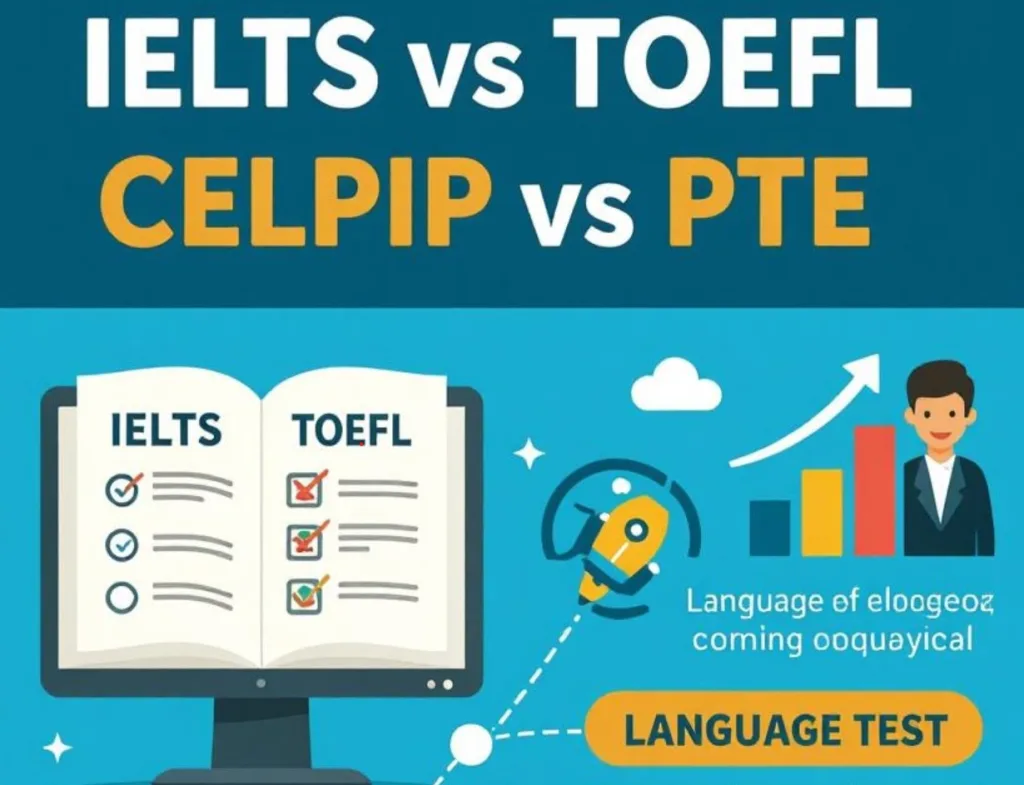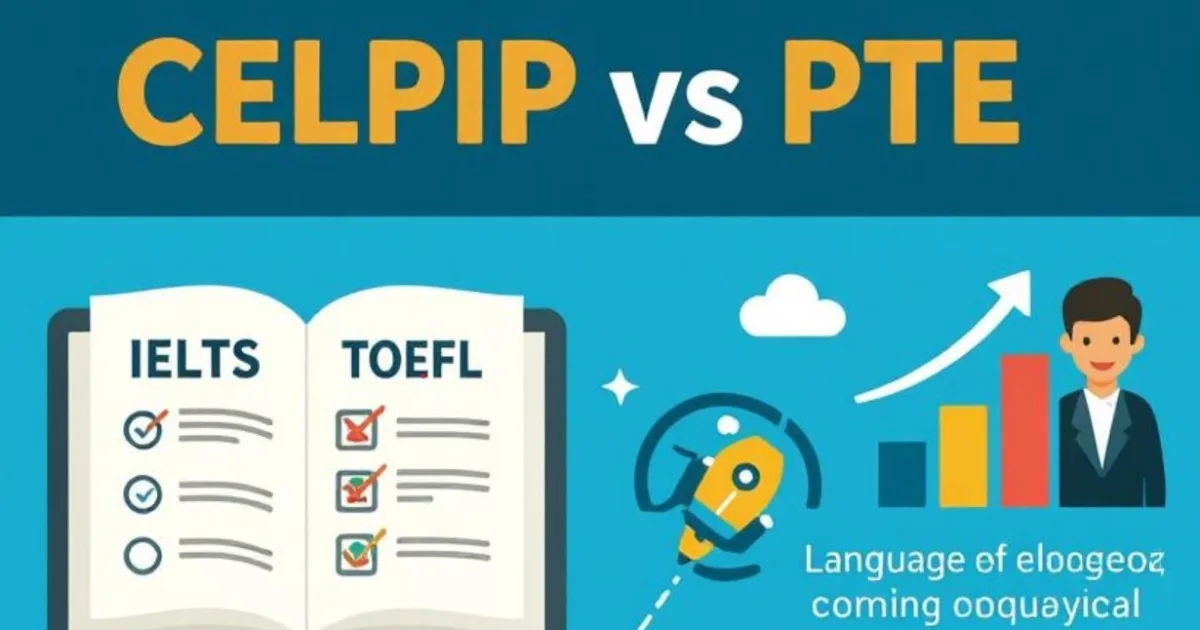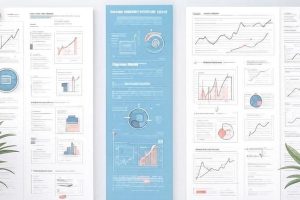Deciding which English proficiency test to take can feel overwhelming. Whether you’re planning to study abroad, immigrate to a new country, or advance your career, choosing the right exam matters more than you might think. I’ve spent considerable time researching these tests, and I’m here to break down everything you need to know about IELTS, TOEFL, CELPIP, PTE, and other popular options.
Why Your Choice of English Test Actually Matters
Before we dive into the comparisons, let’s talk about why this decision deserves your attention. Different countries, universities, and immigration programs accept different tests. Some prefer one over another, while others accept multiple options. Your choice can affect your application timeline, your budget, and honestly, your chances of success.

IELTS: The Global Standard Everyone Knows
The International English Language Testing System, or IELTS as most people call it, has become almost synonymous with English proficiency testing. You’ve probably heard about it from friends or seen it mentioned in university requirements.
Types and Formats
IELTS comes in two flavors. The Academic version is what most students need for university admissions, while the General Training version suits immigration and work purposes. Both versions test the same four skills, but the reading and writing sections differ in content and complexity.
Here’s what makes IELTS unique: you can choose between a paper-based test or a computer-delivered test. The speaking section, however, remains a face-to-face conversation with a real examiner. Many test-takers appreciate this human interaction, though some find it nerve-wracking.
What Skills Are Tested
The test covers listening, reading, writing, and speaking. The listening section plays various accents including British, Australian, and North American English. You’ll hear everything from casual conversations to academic lectures. The reading section throws three long passages at you, filled with complex vocabulary and nuanced arguments.
Writing asks you to complete two tasks within 60 minutes. The first task varies between the Academic and General versions, but Task 2 always requires you to write an essay discussing a viewpoint, argument, or problem. Speaking involves three parts: an introduction, a short speech about a topic, and a deeper discussion with the examiner.
Scoring and Evaluation
IELTS uses a band score system from 0 to 9. Most universities want overall scores between 6.5 and 7.5, though requirements vary. Each section gets its own band score, and your overall score is the average of these four scores, rounded to the nearest half band.
The evaluation process involves trained examiners who follow strict criteria. For writing and speaking, they assess your fluency, coherence, vocabulary range, grammatical accuracy, and pronunciation. The listening and reading sections are more straightforward, with each correct answer contributing to your raw score, which then converts to a band score.
Cost and Availability
Expect to pay between $215 and $310 depending on your location. The test is available multiple times per month in most major cities worldwide. Results typically arrive within 13 days for computer-delivered tests and within 13 days for paper-based tests.
Difficulty Level
Many test-takers describe IELTS as challenging but fair. The face-to-face speaking component can work in your favor if you’re confident in conversations. However, the time pressure in reading and writing catches many people off guard. The listening section plays recordings only once, which demands intense concentration.
Acceptance and Popularity
IELTS is accepted by over 11,000 organizations worldwide. It’s particularly dominant in the UK, Australia, New Zealand, and Canada. Many American universities have started accepting IELTS alongside TOEFL, making it an increasingly versatile choice.
For immigration purposes, IELTS General Training is recognized by immigration authorities in Australia, Canada, New Zealand, and the UK. It’s become the go-to test for anyone pursuing permanent residency in these countries.
TOEFL iBT: The American Academic Favorite
The Test of English as a Foreign Language, specifically the Internet-Based Test (iBT), has long been the preferred choice for students heading to American universities. ETS, the organization behind TOEFL, has refined this test over decades.
Test Structure and Format
TOEFL iBT is entirely computer-based, which means everything happens on screen. The test takes about three hours to complete, and you’ll do all four sections in one sitting. Unlike IELTS, there’s no human examiner for speaking. Instead, you record your responses into a microphone.
The test presents tasks in an academic context. You’ll read passages from university textbooks, listen to lectures and campus conversations, and even combine skills by reading a passage and listening to a lecture before writing or speaking about them.
Skills Assessment
The reading section presents 3-4 passages from academic texts. You’ll answer multiple-choice questions that test your understanding of main ideas, details, inferences, and vocabulary. The listening section includes lectures, classroom discussions, and conversations between students and professors.
Writing involves two tasks: an integrated task where you read, listen, and then write, and an independent task where you express your opinion on a topic. The speaking section includes six tasks mixing independent and integrated questions. You’ll speak about familiar topics and summarize information you’ve read and heard.
Scoring System
TOEFL uses a point-based system, with each section scored from 0 to 30, giving a total score out of 120. Most competitive universities look for scores between 90 and 110. Unlike IELTS’s band system, TOEFL’s scoring feels more granular, with every point potentially making a difference.
AI algorithms help score the writing and speaking sections, working alongside human raters to ensure consistency. This combination of automated and human evaluation aims to provide objective, reliable scores.
Pricing and Scheduling
TOEFL costs around $195 to $300 depending on your country. The test is available year-round at authorized test centers, and you can take it as many times as you want, though you must wait at least three days between attempts. Results arrive within 6 days of your test date.
Difficulty Assessment
Test-takers often describe TOEFL as academically rigorous. The integrated tasks challenge you to combine multiple skills simultaneously, which can be demanding. However, some find the computer-based format more comfortable than speaking to a human examiner.
The academic focus throughout the test means you’ll encounter university-level vocabulary and complex sentence structures. If you’re comfortable with academic English and computer-based testing, TOEFL might suit you well.
Recognition and Usage
TOEFL is accepted by over 11,500 universities and institutions across 160 countries. It dominates in the United States, where most universities prefer it for international admissions. However, it’s less commonly accepted for immigration purposes compared to IELTS.
Many graduate programs, especially in sciences and engineering, favor TOEFL because of its academic orientation. If you’re planning to study in the US or pursue graduate studies anywhere, TOEFL remains a strong choice.
CELPIP: Canada’s Preferred Test
The Canadian English Language Proficiency Index Program is less known internationally but incredibly important for Canadian immigration. If Canada is your destination, you need to understand this test.
Format Specifics
CELPIP comes in two versions: CELPIP-General for immigration and professional designation, and CELPIP-General LS, which tests only listening and speaking for citizenship applications. The entire test is computer-delivered and uses Canadian English spellings, pronunciation, and scenarios.
What sets CELPIP apart is its focus on everyday Canadian situations. You’ll encounter scenarios about workplace interactions, community involvement, and daily life situations that feel remarkably practical.
Skills Coverage
The listening section features conversations, problem-solving discussions, and informational messages. The reading passages include correspondence, advertisements, and informational texts you’d encounter in Canadian daily life.
Writing tasks ask you to write emails and respond to survey questions expressing your opinion. Speaking tasks involve giving advice, describing scenes, making predictions, and comparing options. These tasks feel more practical and less academic than TOEFL or IELTS Academic.
Grading Approach
CELPIP uses a scale from 1 to 12 for each skill, called the Canadian Language Benchmark (CLB) levels. For immigration purposes, the required levels vary by program, but most economic immigration programs require CLB 7 or higher in each skill.
The scoring is criterion-referenced, meaning your performance is measured against specific descriptors rather than compared to other test-takers. This approach aims to provide consistent results regardless of when you take the test.
Cost and Availability
CELPIP costs around $280 to $300 CAD. It’s primarily available in Canada and select international locations with significant Canadian immigration interest. Test dates are frequent in major Canadian cities, and results typically arrive within 8 business days.
Difficulty Comparison
Many test-takers find CELPIP more straightforward than IELTS, particularly in speaking where you respond to a computer rather than a person. The Canadian context and practical scenarios make the test feel relevant and less intimidating.
However, the computer-based speaking can be challenging if you’re not comfortable talking to a screen. The lack of human interaction means you can’t gauge reactions or receive any feedback during the test.
Acceptance Patterns
CELPIP is fully accepted by Immigration, Refugees and Citizenship Canada (IRCC) for all immigration programs. It’s also accepted for professional designations in Canada. However, its recognition outside Canada is limited.
For Canadian immigration, particularly Express Entry and Provincial Nominee Programs, CELPIP has gained immense popularity because it’s designed specifically for this purpose. Many immigrants find it more aligned with their needs than IELTS General Training.
PTE Academic: The Tech-Forward Option
Pearson Test of English Academic represents the newer generation of language testing, with completely automated scoring and high-tech delivery methods.
Test Design
PTE Academic is entirely computer-based and completed in one three-hour session. The test sections aren’t clearly divided; instead, tasks flow from one to another, with some questions testing multiple skills simultaneously.
You’ll encounter 20 different task types, from reading aloud and repeating sentences to essay writing and summarizing written texts. The variety keeps the test engaging but requires thorough preparation to master all formats.
Skill Integration
PTE Academic emphasizes integrated skills more than other tests. For example, you might see a passage and then speak your summary, or listen to a lecture and type a written summary. This approach mirrors real-world language use where skills overlap.
The listening section includes various accents and speeds. Reading passages cover academic and general interest topics. Writing tasks include summarizing written texts and writing essays. Speaking involves reading aloud, repeating sentences, describing images, and more.
Scoring Mechanics
PTE uses a scale from 10 to 90 points for overall and section scores. What makes PTE unique is its completely automated scoring using AI algorithms. There’s no human judgment involved, which ensures consistent application of scoring criteria.
The automated system analyzes pronunciation, fluency, vocabulary, grammar, spelling, and content. While this removes potential human bias, it also means the system might miss contextual nuances that human raters would catch.
Pricing and Logistics
PTE Academic costs around $200 to $250 depending on location. The test is available throughout the year at Pearson test centers and even at home through PTE Academic Online. This flexibility makes it easier to schedule around your commitments.
Results arrive incredibly fast, often within 48 hours. This quick turnaround is a significant advantage if you’re working with tight application deadlines.
Challenge Level
Opinions on PTE’s difficulty vary widely. Some find the automated format easier because there’s no pressure of human interaction. Others struggle with the variety of task types and the need to manage time across integrated sections.
The speaking section can be particularly tricky because the AI scoring emphasizes pronunciation and fluency heavily. If you have a strong accent or speak with hesitation, you might find PTE more challenging than IELTS.
Market Position
PTE Academic is accepted by thousands of universities worldwide, including many in Australia, New Zealand, the UK, and increasingly in the US. It’s also accepted for Australian and New Zealand visa applications, making it a viable alternative to IELTS for these destinations.
The test has gained popularity among students who prefer computer-based testing and need quick results. Its acceptance continues to grow, though it hasn’t yet reached IELTS or TOEFL’s level of universal recognition.
Other Notable English Tests
While IELTS, TOEFL, CELPIP, and PTE dominate the market, several other tests serve specific purposes or regions.
Duolingo English Test
This relatively new test has gained surprising traction, especially after the pandemic normalized remote testing. You can take it from home in under an hour for around $49, making it the most affordable and convenient option.
The test adapts to your level, becoming harder or easier based on your responses. It scores from 10 to 160 and provides results within 48 hours. Over 4,000 institutions now accept it, though it’s still building credibility compared to established tests.
Cambridge English Exams
Cambridge offers a suite of exams at different levels, including C1 Advanced and C2 Proficiency. These tests are particularly respected in Europe and provide lifetime certificates rather than scores valid for two years.
The exams are rigorous and thoroughly test all language skills. They’re often used for university admissions in the UK and Europe, and many professional organizations recognize them for employment purposes.
TOEIC
The Test of English for International Communication focuses on workplace English rather than academic language. It’s popular in corporate environments, particularly in Asia, where companies use it to assess employees’ English proficiency.
TOEIC comes in different formats testing listening, reading, speaking, and writing. It’s less relevant for students but crucial for professionals seeking jobs with international companies.
Making Your Decision: Which Test Should You Take?
Your destination determines much of this decision. If you’re moving to Canada for immigration, CELPIP or IELTS General Training are your primary options. For US universities, TOEFL or IELTS Academic work best. Australian and UK institutions accept multiple tests but favor IELTS.
Consider your strengths and preferences. If you prefer human interaction, IELTS’s face-to-face speaking might suit you. If you’re comfortable with technology and want quick results, PTE or Duolingo could be ideal. If you’re strong in academic English, TOEFL might play to your strengths.
Budget matters too. If cost is a concern, Duolingo offers tremendous value, though you should verify it’s accepted by your target institutions. TOEFL, IELTS, CELPIP, and PTE fall within a similar price range, so cost alone shouldn’t determine your choice among these options.
Think about preparation time and resources. IELTS and TOEFL have abundant preparation materials because they’ve been around longer. CELPIP and PTE have fewer resources, though this gap is narrowing. Choose a test with adequate preparation materials available in your area or online.
Preparation Strategies That Work Across All Tests
Regardless of which test you choose, certain preparation principles apply universally. Immerse yourself in English daily through reading, listening to podcasts, watching videos, and speaking whenever possible. This natural exposure builds the language foundation that test-specific strategies build upon.
Take official practice tests to understand the format and timing. Each test has unique quirks and question types that you need to master. Practice under timed conditions to build the stamina needed for test day.
Focus on your weak areas but don’t neglect your strengths. It’s tempting to focus only on improving weak skills, but maintaining strong skills ensures they shine on test day. Balanced preparation yields the best overall scores.
Consider formal preparation courses if self-study isn’t working. Many test prep companies offer specialized courses for each test, and some candidates benefit tremendously from structured learning and expert guidance.
Quick Comparison Table
To help you see the differences at a glance, here’s a comprehensive comparison of the major English language tests:
| Feature | IELTS | TOEFL iBT | CELPIP | PTE Academic | Duolingo |
|---|---|---|---|---|---|
| Test Duration | 2h 45min | ~3 hours | ~3 hours | ~3 hours | ~1 hour |
| Format | Paper/Computer + Face-to-face speaking | Computer-based | Computer-based | Computer-based | Computer-based (at home) |
| Score Range | 0-9 bands | 0-120 points | 1-12 CLB levels | 10-90 points | 10-160 points |
| Cost | $215-$310 | $195-$300 | $280-$300 CAD | $200-$250 | $49 |
| Results Time | 3-13 days | ~6 days | ~8 days | ~48 hours | ~48 hours |
| Validity | 2 years | 2 years | 2 years | 2 years | 2 years |
| Speaking Format | Face-to-face examiner | Microphone recording | Computer recording | Computer recording | Computer recording |
| Skills Tested | L, R, W, S | L, R, W, S | L, R, W, S | L, R, W, S | L, R, W, S |
| Test Focus | General/Academic | Academic | Practical Canadian | Academic | General/Academic |
| Best For | UK, Australia, Canada immigration | US universities | Canadian immigration | Australian visas | Quick admissions |
| Difficulty Level | Moderate to Hard | Moderate to Hard | Moderate | Moderate | Easy to Moderate |
| Global Recognition | 11,000+ institutions | 11,500+ institutions | Mainly Canada | 3,000+ institutions | 4,000+ institutions |
| Retake Wait Time | No restriction | 3 days | No restriction | No restriction | No restriction |
| Accent Used | British, Australian, American | American | Canadian | Various | American |
Acceptance by Country: Visual Breakdown
Understanding which tests are preferred in different countries helps narrow your choice significantly:
Primary Test Preferences by Destination
United States
- TOEFL: 85% preferred
- IELTS: 90% accepted
- PTE: 60% accepted
- Duolingo: 40% accepted
United Kingdom
- IELTS: 95% preferred
- PTE: 75% accepted
- TOEFL: 70% accepted
- Cambridge: 80% accepted
Canada (Immigration)
- IELTS General: 100% accepted
- CELPIP: 100% accepted
- TEF (French): For Quebec
Canada (Universities)
- IELTS Academic: 100% accepted
- TOEFL: 95% accepted
- CELPIP: 75% accepted
- Duolingo: 50% accepted
Australia
- IELTS: 100% accepted
- PTE: 100% accepted
- TOEFL: 90% accepted
- Cambridge: 85% accepted
New Zealand
- IELTS: 100% accepted
- PTE: 95% accepted
- TOEFL: 85% accepted
Score Equivalency Comparison
Understanding how scores translate between tests helps you set realistic targets. Here’s an approximate equivalency chart:
| IELTS Band | TOEFL iBT | CELPIP | PTE Academic | Duolingo | Proficiency Level |
|---|---|---|---|---|---|
| 9.0 | 118-120 | 12 | 86-90 | 155-160 | Native/Near-native |
| 8.5 | 115-117 | 11 | 83-85 | 145-150 | Very proficient |
| 8.0 | 110-114 | 10 | 79-82 | 135-140 | Proficient |
| 7.5 | 102-109 | 9 | 73-78 | 125-130 | Good proficiency |
| 7.0 | 94-101 | 9 | 65-72 | 115-120 | Competent |
| 6.5 | 79-93 | 8 | 58-64 | 105-110 | Modest competence |
| 6.0 | 60-78 | 7 | 50-57 | 95-100 | Acceptable |
| 5.5 | 46-59 | 6 | 42-49 | 85-90 | Limited |
| 5.0 | 35-45 | 5 | 35-41 | 75-80 | Basic |
Note: These are approximate equivalencies. Different institutions may interpret scores differently.
Cost Comparison Over Multiple Attempts
Many test-takers need multiple attempts to achieve their target scores. Here’s what that looks like financially:
| Test | Single Attempt | Two Attempts | Three Attempts | Plus Score Reports |
|---|---|---|---|---|
| IELTS | $265 (avg) | $530 | $795 | $40-$60 per institution |
| TOEFL | $245 (avg) | $490 | $735 | Free to 4 institutions, $20 each after |
| CELPIP | $290 | $580 | $870 | $90 for re-check |
| PTE | $225 | $450 | $675 | Unlimited free score reports |
| Duolingo | $49 | $98 | $147 | Unlimited free score reports |
Test Difficulty Rating by Skill
Based on test-taker feedback and success rates, here’s how each test rates for difficulty across different skills (1=Easiest, 5=Hardest):
| Test | Listening | Reading | Writing | Speaking | Overall |
|---|---|---|---|---|---|
| IELTS | 4/5 | 4/5 | 4/5 | 3/5 (with examiner) | 4/5 |
| TOEFL | 4/5 | 5/5 | 4/5 | 3/5 (to computer) | 4.5/5 |
| CELPIP | 3/5 | 3/5 | 3/5 | 3/5 | 3/5 |
| PTE | 4/5 | 4/5 | 3/5 | 4/5 (AI scoring) | 4/5 |
| Duolingo | 2/5 | 3/5 | 2/5 | 2/5 | 2.5/5 |
Key difficulty factors:
- IELTS: Face-to-face speaking can help or hinder; listening plays once only
- TOEFL: Academic vocabulary throughout; integrated tasks are complex
- CELPIP: Most straightforward; Canadian context familiar to many
- PTE: Variety of task types requires extensive practice; AI scoring strict on pronunciation
- Duolingo: Shortest and most flexible, but growing in difficulty
The Bottom Line
Choosing between IELTS, TOEFL, CELPIP, PTE, and other English tests depends on your specific goals, destination, preferences, and strengths. There’s no universally “best” test, only the best test for your situation.
Research your target institutions’ requirements thoroughly before committing to a test. Verify acceptance policies, minimum score requirements, and whether they have preferences among accepted tests. This homework prevents costly mistakes and wasted preparation time.
Remember that these tests measure your current English ability. While test-taking strategies help, the most reliable way to achieve your target score is genuinely improving your English proficiency. View test preparation as an opportunity to enhance your language skills for long-term success, not just as a hurdle to clear.
Whatever test you choose, approach it with confidence and adequate preparation. Thousands of people successfully navigate these tests every day, and with the right approach, you’ll join their ranks. Your English proficiency journey doesn’t end with the test; it’s just the beginning of new opportunities in education, career, or a new country.




